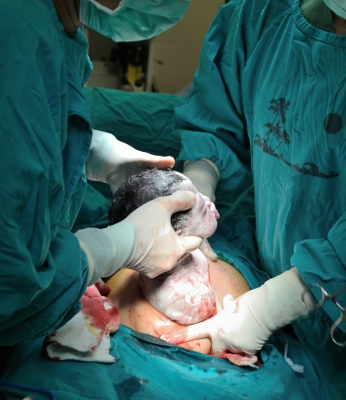Vaginal Birth after Caesarean Section (VBAC)
- Aim for a vaginal delivery. About 60-80% of women who choose this will be successful in giving birth to their babies vaginally. About 20-40% will need to have a further Caesarean section
- The second option is to have a planned (elective) Caesarean section
- women who had a vertical uterine scar (classical incision) instead of low transverse (almost 95% of incisions are low transverse, therefore it is important that your obstetrician have a copy of your previous Caesarean delivery to be sure which type of incision was made on your uterus. Please note that the incision on your skin is not reflective of the type of incision on your uterus).
- Women who have had more than 2 Caesarean deliveries are considered unsuitable for a trial of vaginal birth as the risk of uterine rupture is high. However, it is common that the obstetrician advise women with 2 previous Caesarean sections against a trial of vaginal birth.
- Women with previous history of uterine rupture as the risk of recurrent rupture is unknown
- In the case of unsuccessful trial of vaginal birth due to slow cervical dilatation or your baby become distress during the process of labour, you will end up with an emergency Caesarean section. We know that there is a slightly higher chance of complications with an emergency Caesarean section compared to a planned (elective) Caesarean section.
- One of the major concerns for women who have had a previous Caesarean birth is the risk of the scar on the womb opens up (uterine rupture) during a trial of vaginal birth. If you had a previous Caesarean section with low transverse incision, the risk is around 0.5%. This is if you go into labour on your own. If you required oxytocin to help to kick start your labour or make your contractions stronger, then the risk is quoted to be 0.8%. The risk of uterine rupture increases to 2.5% if your required prostaglandin to start off your labour.
- We would think carefully before inducing labour in a women with a previous Caesarean section
- You are strongly recommended to have a trial of vaginal birth in a hospital setting for emergency Caesarean section
- During labour, blood would be taken and a cannula inserted into your hand and arm so that we could quickly connect a drip if you need to go to the operating theatre quickly
- The progress of your labour and the baby’s condition would be monitored closely. It is recommended we continuously monitor your baby’s heart rate with an electronic fetal monitoring machine following the onset of uterine contractions.
|
Repeat Caesarean Section
|
VBAC
|
|
Risk of Caesarean section
(please refer to the topic what are
the risk
of Caesarean section )
|
0.5-1.0% risk of the scar on the
womb opening up (uterine
rupture). If this occur,
it can cause serious internal
bleeding and can be dangerous
for both
|
|
Hospital stay of 2-3 days or even
longer depending on the
circumstances of your Caesarean
section
|
Hospital stay of approximately 1-2
days
|
|
Increased risk of infection to the
womb, bladder and skin
|
Risk of infection is higher if you
ended up with an emergency
Caesarean section
|
|
Injury to the internal organs such
as bladder, bowel or adjacent
organs
|
Risk of an episiotomy if you need
one to deliver your baby
|
|
Risk of blood clot formation in the
legs or lungs
|
Lower risk of blood clot formation
in the legs or lungs
|
|
More pain relief required after the
procedure
|
Lower requirement of pain relief
|
|
Risk of anaesthesia. However, with
the development of modern
anaesthesia technique such as
epidural and spinal anaesthesia, the
risk has been reduced remarkably
|
|
|
On-going pain due to scar tissue
formation in abdomen
|
Short term pain and discomfort
around vagina
|
|
Longer recovery
|
Shorter recovery
|
|
Higher cost
|
Lower cost
|
|
If you plan to have many more
children, you need to take this into
consideration as the risk of surgery
increases with the number of
surgery you have had. Therefore, a
repeat Caesarean section may limit
the number of children you could
have
|
|
|
A small risk of baby having
breathing difficulties upon delivery
|








